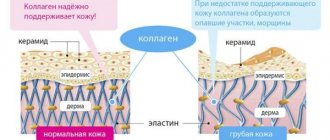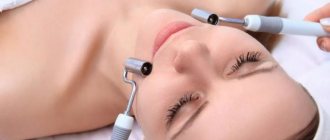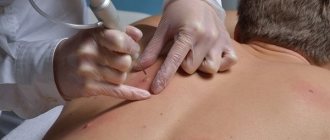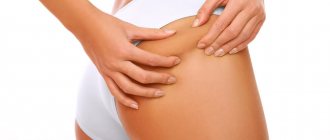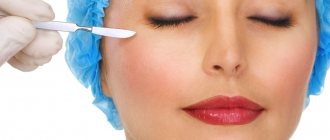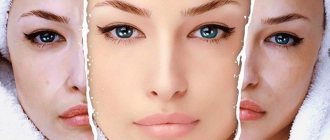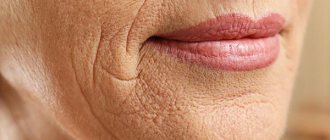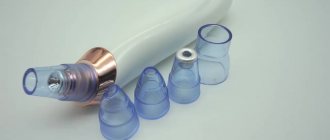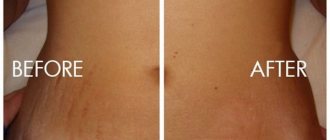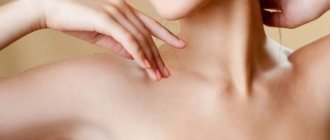This skin defect is considered cosmetic and also more common in women than men. There is a large review article on our website about what stretch marks are and how you can get rid of them. There are quite a lot of methods of control, from simple home recipes of traditional medicine to surgical intervention. Today we will talk about laser resurfacing of stretch marks, which “works” only on damaged areas of the skin, while leaving the healthy epidermis intact. Let's figure out what this method is, what principle it works on and what results you can expect.
What's happened
Laser stretch mark resurfacing is a process that completely removes dead superficial epithelial tissue, as well as some of the deeper dermal layers.
As a result of skin damage, fibroblasts begin to become active, which contribute to the natural production of collagen and elastin. It is these fibers that keep the skin in normal condition.
During the manipulation, the laser displaces connective tissue and destroys stretch marks, resulting in faster renewal of the epidermis at the cellular level.
On this topic
- Other
Laser scar resurfacing
- Olga Aleksandrovna Kalinina
- October 18, 2020
Thanks to the influence of the laser beam, regeneration and recovery occur at a faster pace, blood circulation improves and metabolic processes accelerate. In the place where the damaged epithelium was previously located, new tissue is formed, which has increased elasticity and elasticity.
The surface of the skin is smoothed and tightened, leaving no trace of stretch marks. If stretch marks appeared a long time ago and are located deep in the dermis, laser resurfacing will significantly reduce their severity.
Advantages and disadvantages
After laser removal, stretch marks disappear immediately after the session. Thus, you can see from personal experience how effective such manipulation is. Cosmetic clinics use only modern equipment equipped with a special device that provides contact cooling to the surface of the epidermis.
Laser correction is suitable for treating any area of the body. At the same time, pigment spots, spider veins and birthmarks can be eliminated simultaneously with stretch marks.
Resurfacing stretch marks with a laser is not a surgical procedure, which makes it possible to perform it not only in a hospital, but also in a beauty salon.
On this topic
- Other
Laser callus removal
- Olga Aleksandrovna Kalinina
- October 18, 2020
After the procedure, there is a noticeable improvement in the skin. It becomes smooth and silky. As a result, natural rejuvenation and healing of the epidermis occurs.
Despite such a large number of advantages, using a laser to remove stretch marks on the skin has a number of disadvantages. First of all, it should be noted that in order to obtain the desired result, you will have to be patient and time-consuming, since only 1 millimeter of an area can be treated in one manipulation. To remove all defects, a full course consisting of several procedures will be required.
During the rehabilitation period, the patient may experience some discomfort, which is manifested by itching of varying degrees of intensity, soreness and peeling. If there are old stretch marks, then there is a possibility that you will not be able to get the result that the patient expected.
Methods
There are two ways to remove stretch marks with laser.
Full sanding
To perform this type of technique, an erbium laser is used. The depth of exposure of the beam at which evaporation of cellular structures occurs is preset. At the same time, natural processes of rejuvenation and regeneration occur over the entire surface of the problem area.
After ablation, fibroblasts begin to work, which helps to activate recovery processes in the body.
In some situations, manipulation is performed using a local anesthetic. If a large area is being treated, general anesthesia may be administered.
Fractional thermolysis
The difference from the previous method is that here only certain areas are affected, during which nearby tissues remain not involved in the process. This technology allows you to achieve better results.
Nanoperforation
This is a method of laser removal of stretch marks, in which microscopic effects are noted. When the beam scatters, the code receives microdamage, which is restored over time. At the same time, activation of the synthesis of hyaluronic acid, collagen and elastin fibers is observed in the skin.
Due to this, stretch marks are smoothed out and the skin is rejuvenated.
Mastopexy, or plastic surgery for stretch marks in the breast area and breast lift
In the breast area, plastic surgery solves the problem of stretch marks through an intervention called mastopexy. Among women who have given birth, this operation is especially in demand, because it solves the most pressing problem - sagging breasts. Its essence is to remove excess tissue by excision. As a result, the patient not only receives lifted breasts, but also gets rid of stretch marks that were located in the area of the tissue to be excised. In addition, stretch marks become less noticeable due to the tension of the breast skin.
Just as in the case of abdominoplasty, mastopexy can be of several types. The determining factor here is the degree of breast ptosis. So, if the breasts are minimally drooping, and the tone in the breast tissue is preserved, then in this case the most aesthetic and least traumatic type of breast lift will be indicated, which involves making an incision around the areola, through which the excess skin structures are removed. If the breast is deformed quite severely, the surgeon will choose the “anchor-shaped” approach technique, which involves an incision under the areola, a vertical incision going down from it and a horizontal one adjacent to it, located in the fold under the breast. This method is considered the most effective in plastic surgery for removing stretch marks from the breast, since during the manipulation process a large amount of excess tissue is excised in different areas, which are also affected by numerous stretch marks.
Contraindications for breast lift and stretch mark removal: plastic surgery
And contrary to popular rumors, plastic surgery for stretch marks in the breast area and breast lift in no way affects a woman’s reproductive function or the health of her body as a whole. The only thing is that surgeons still recommend that women who have not given birth or are planning a pregnancy in the future refrain from this operation, since during pregnancy and lactation the breasts may become deformed again.
As for the cases where breast plastic surgery will be refused, they are identical to the contraindications for abdominoplasty.
Types of lasers
Stretch marks can be removed using several types of lasers. The choice of a particular device will depend on the severity of the existing problem.
Erbium
Has a gentle effect. Effective in removing stretch marks that may appear after childbirth. The rays penetrate to a depth of no more than 5 microns.
The procedure is performed as quickly as possible, as a result of which, when removing dead cells, nearby areas simply do not have time to warm up. It is due to this feature that this type of laser is also called cold.
It will be possible to evaluate the final result after the manipulation no earlier than in a week, when the skin gradually begins to recover.
Fraxel
In this case, low frequency energy is used. Suitable for sensitive skin. It is considered one of the safest, since all manipulations affect only superficial tissues.
A noticeable result is visible with fresh stretch marks located shallow to the surface of the epidermis.
Palomar
Characterized by high-precision effects on problem areas. When light microbeams penetrate the epidermis, the tissues heal naturally.
Shows good results in eliminating deep and old stretch marks.
Dermal optical thermolysis
This is a more modern and ultra-effective method, in which the effect on the epidermis occurs selectively. As a result, the skin receives multiple damage, due to which the synthesis of its own collagen is activated.
This method is suitable for people who have old stretch marks. The effectiveness of the procedure is characterized by leveling the surface layers of the epithelium, removing stretch marks, scars, increasing elasticity, and eliminating age spots.
Up to five sessions will be required to achieve the desired result.
excimer
Suitable for eliminating old stretch marks. This is a non-invasive but effective technique. Thanks to a powerful ultraviolet ray, connective tissue is destroyed. A crust begins to form on the surface of the skin, which falls off on its own over time. In its place, new tissue structures are formed.
At the same time, the production of melanin is stimulated, due to which the shade of the stretch marks becomes the same as the healthy integument of the epidermis.
Despite the positive results, this technique is contraindicated for women who are allergic to sunlight.
The procedure lasts on average about 40 minutes, and the recovery period takes up to 21 days.
Who is indicated for laser treatment of striae?
Many people think that stretch marks on the body appear only after pregnancy, but this is not true. Indeed, almost 60% of women face such a problem as stretch marks after childbirth, but pink scars on the body can also appear under the influence of other factors, for example, when taking hormonal medications or drugs from the group of anabolic steroids. Very often, stretch marks appear in athletes who strive to build muscle mass in a short time (in this case, stretch marks are most noticeable on the inside of the arms, in the shoulder girdle), as well as in children who are rapidly gaining weight and are obese.
In athletes, stretch marks may appear in the shoulder area
In the absence of contraindications, laser treatment of stretch marks can be recommended for the following categories of patients:
- people suffering from hormone-dependent diseases or forced to take hormonal medications for a long time;
- women after childbirth (only after completion of lactation and not earlier than six months after the birth of the child);
- patients who have suddenly gained weight or, conversely, lost a large number of extra pounds in a short period of time;
- adolescents with body weight that does not correspond to age-specific anthropometric standards.
Note! Laser therapy in adolescence is usually carried out no earlier than 16 years of age, but if there are emergency indications and there are no restrictions, the doctor may allow treatment for patients starting from the age of fourteen.
The doctor prescribes laser treatment after a thorough examination.
Indications
Stretch marks can appear on any part of the body. In addition, they appear not only after childbirth, but also due to the development of certain pathological processes.
On this topic
- Other
Non-injection lip augmentation
- Olga Aleksandrovna Kalinina
- October 18, 2020
Thus, laser treatment of striae is recommended for people who have the following conditions:
- hormone-dependent pathologies;
- postpartum period for women;
- sudden weight , or vice versa rapid weight loss;
- forced use of hormonal drugs.
In addition, the procedure can be performed in adolescence if the child’s body weight does not meet established standards, which also causes the formation of a similar defect on the skin.
Preventing the appearance of stretch marks (prevention)
It is well known that it is easier to carry out prevention than to treat the consequences. In this case, regarding stretch marks, this rule also works. The only preventive means against stretch marks are cosmetic creams, gels, serums containing moisturizing components and collagen. It is also recommended to use natural oils - olive, peach, almond, etc.
In the event that it is clearly known that you are in one or another risk group for stretch marks (diet, pregnancy, pumping up muscles, etc.), it makes sense to use preventive measures in advance. In addition, it has been scientifically proven that genetics determines skin structure. A person inherits the skin of his parents, and if one of them had stretch marks, then you may also experience them.
As another recommendation, you can also recommend a massage using a variety of oils and creams containing not only moisturizing, but also vitamin components. Among other things, you need to take a reasonable and step-by-step approach to diets, physical activity, etc., so as not to treat the stretch marks that appear later.
Contraindications
Removing stretch marks with a laser is prohibited if you have problems such as:
- oncological diseases ;
- pathologies of the heart and blood vessels;
- diseases of the endocrine system;
- inflammatory processes on the skin at the sites of intended impact;
- burns resulting from visiting a solarium or prolonged exposure to open sunlight;
- tendency to form keloid scars;
- chronic diseases in the acute stage;
- diseases of infectious and inflammatory origin at the stage of decompensation;
- diagnosed diabetes mellitus ;
- epileptic seizures.
The period of pregnancy and breastfeeding is also contraindicated.
Micro-resurfacing of skin for stretch marks
Microdermabrasion or microresurfacing is the most painless and gentle method of getting rid of “dead” cells and stimulating the process of skin regeneration. This method can be called peeling.
Its main goal is to combat skin aging.
Microcrystals of aluminum oxide exfoliate the keratinized epidermis and polish the skin. As a result, the skin is smoothed, evened out and acquires a healthy shade.
Cosmetic resurfacing of stretch marks is aimed at:
- skin rejuvenation;
- smoothing out small wrinkles;
- reduction of age-related pigmentation;
- production of elastin and collagen.
A long course of microresurfacing (about 10-20 procedures) ensures the removal of stretch marks, scars, keloids, and relief from the consequences of acne.
Progress
In modern clinics, the fractional and classical method of laser stretch mark removal is becoming increasingly popular.
In general, the procedure involves performing a number of general sequential actions.
First, the skin in areas requiring correction is cleaned of impurities and treated with an antiseptic solution. After this, a cream with an anesthetic effect is applied to the skin. Next, the specialist uses the device to set the exposure parameters and select the most suitable laser attachment.
The classical method uses an erbium laser, where a special tip is used to target problem areas with beam beams. In this case, all movements are performed along the direction of the stretch line.
When the beam penetrates to a certain depth, tissue fragments are evaporated, as a result of which fibroblasts are activated and trigger tissue renewal processes. In this way, self-healing occurs at the cellular level.
The technology for performing fractional thermolysis has principles similar to the method described above. However, in this case the laser beam acts more accurately. Nearby tissues are not affected. Thanks to such ultra-precision, even the smallest stretch marks can be removed.
At the final stage, the treated areas are wiped with an antiseptic again, after which the wound-healing agent Panthenol is applied to them.
Methods of laser therapy for stretch marks
Stretch marks on the face and body can be removed using laser in two ways: deep laser resurfacing and fractional laser thermolysis. The second option is more gentle, since it does not injure surrounding tissues, and during the procedure itself the patient experiences less pain, but the effect of fractional resurfacing is less pronounced compared to deep processing.
Deep grinding
Deep (classical) skin resurfacing is a highly effective method of combating stretch marks, based on deep heating of dermal cells. For this type of laser therapy, a CO2 (CO2) carbon dioxide laser is used, which is capable of emitting a light pulse in the infrared range with a penetration depth of up to 20 microns. This allows for a combined clinical effect: the laser not only “seals” the outer layer of the skin, but also causes a complete renewal of the deep layers due to traumatization of all epidermal cells at a given depth.
Carbon dioxide laser provides treatment of deep layers of skin
The deep laser resurfacing procedure is quite painful and, if it is necessary to treat large areas (for example, the abdomen), it may require the use of general anesthesia. In other cases, local anesthesia is used with gels, which include local anesthetics - lidocaine and prilocaine. After treatment, the skin looks burned, swelling and bruising may appear. The rehabilitation period after such exposure ranges from 7-10 days to 2-3 weeks. Since the grinding process traumatizes the deep layers of the dermis, white or yellow crusts may appear on the surface of the treated area after the procedure.
Emla cream - local anesthetic
Important! Despite the painfulness of the procedure, the complexity and duration of the recovery period, deep skin resurfacing is indicated for patients with old scars, more than 6 months have passed since their appearance. More gentle methods of laser therapy will be ineffective for correcting such stretch marks.
Fractional photothermolysis
The method of fractional resurfacing of scars and stretch marks is comfortable for the patient, since this method uses a fragmented (point) effect on the problem area, as a result of which the surrounding tissues are not damaged and retain their structure. The laser beam in fractional lasers is scattered into many micro-streams, creating microthermal treatment zones, the number of which can range from several tens to several thousand (depending on the area being treated).
Fractional resurfacing is a more gentle procedure
Fractional resurfacing of stretch marks can be performed in three ways: ablative, non-ablative and combined, combining the principles of the two previous methods.
Methods for fractional resurfacing of stretch marks
| Method | Peculiarities |
| In terms of the mechanism of action and the result obtained, this method can be compared with classical grinding with a gas (carbon dioxide) laser. All layers of the epidermis - the surface layer of the skin - are exposed, while the fibers located in the deep layers of the dermis remain untouched. Recovery after ablative laser treatment occurs much faster than after deep resurfacing, while the method itself is more comfortable for the patient due to the moderate intensity of pain during laser operation. |
| Non-ablative thermolysis (Fraxel and Palomar lasers) is a deep resurfacing procedure that affects not only the epidermis, but also the papillary and reticular layers of the dermis. Using this method, it is possible to achieve deep skin renewal, which continues even several months after the procedures due to the active production of the dermis’ own fibrillar components. |
| Combined thermolysis | Combined techniques can combine both combinations of ablative and non-ablative effects, as well as their variations with other methods of hardware cosmetology, for example, carboxytherapy. |
The fractional laser resurfacing procedure is not considered painful, although some patients complain of severe discomfort during the laser operation. Like classic resurfacing, fractional thermolysis requires preliminary anesthesia with local anesthetics. Visible results after using this method of removing stretch marks can be noticed after the first procedure, although the full course usually consists of 4-8 procedures.
Changes in skin structure after laser therapy
The recovery period after using a fractional laser is shorter than after deep resurfacing, but in patients with increased sensitivity it can be more severe, so they need to refrain from going outside, to public places and to work for several days.
After care
To get the desired effect and prevent the development of consequences, you must adhere to certain rules during the rehabilitation period. First of all, the treated surface should not be touched or wet at first.
Over the course of a week, these areas should be lubricated with special wound-healing agents at least five times a day.
For 2-3 weeks, it is prohibited to use scrubs and do any procedures that involve the use of exfoliating agents. Sleeping is only allowed on the opposite side.
On this topic
- Other
How to remove dark circles under the eyes in cosmetology
- Olga Aleksandrovna Kalinina
- September 23, 2020
You will need to take antibacterial medications for at least 10 days. This will help prevent pathogenic bacteria from penetrating the wound surface.
If severe pain is a concern, then medications with analgesic properties are prescribed.
It is recommended to apply sunscreen to the surface of the skin for at least a month before going outside.
Pros and cons of laser stretch mark removal
This procedure has many advantages. Laser is an effective tool for removing a wide range of skin defects, including pigmentation, scars, spider veins, stars, etc.
Laser stretch mark removal has become very popular, because among its advantages :
- No pain due to anesthesia.
- Instant effect immediately after the procedure.
- Elimination of both newly formed and old stretch marks.
- Safety.
- Long-term results.
The main disadvantage of laser stretch mark removal is long-term rehabilitation after the procedure. The laser can burn up to 1 mm of the epidermis in just one session, depending on the age and depth of the stretch marks. And after this, the skin must restore the injured areas, covering itself with a new layer. Typically, the rehabilitation period is about a month.
This leads to the second disadvantage - the duration of the course. The procedure itself is quick, but the course of treatment consists of four to five sessions, so it may take you about six months. Considering skin problems during the rehabilitation period (itching, peeling, redness), this period causes discomfort for many. Clients are motivated only by increasingly noticeable results after each subsequent session of laser stretch mark removal.
The effectiveness of laser stretch mark removal is lower when affecting old stretch marks; it will not be possible to completely get rid of them. Thanks to the procedure, such stretch marks can be made less noticeable, smooth and uniform in color. But traces of such damage will still remain.
Discomfort and itching are another disadvantage of laser stretch mark removal. The procedure itself is painless, but the rehabilitation period is accompanied by unpleasant sensations in the treated area, similar to a sunburn.
Despite the fact that laser exposure is the most effective in the fight against stretch marks, it cannot always be used due to the presence of a number of contraindications.
Read material on the topic: How to remove wrinkles on the face: the most effective methods
Consequences and complications
After removing stretch marks using the classical method, many patients note the appearance of local redness, swelling and pain, which persists for a long period. The cause of swelling can be mechanical damage to the skin. As a rule, such symptoms disappear on their own after 5-7 days.
After several sessions, complications may arise such as microburn, increased size of stretch marks, or a more saturated color of stretch marks. The reason for this is often the use of outdated equipment during the procedure, the specialist’s violation of the rules for performing the manipulation, and the patient’s failure to comply with recommendations at the stage of preparation and recovery.
Preparation before the procedure
During the procedure, the top layer of skin is injured. Medium - warming up. Therefore, before resorting to this event, you should undergo an examination:
- Initially, you need to go for a consultation with a therapist. He will eliminate all contraindications and confirm that grinding will not harm your health.
- A dermatologist will evaluate the condition of your skin. This will allow you to choose the most effective treatment for the problem.
- Stop sunbathing 3 weeks before your planned event. You should not visit the solarium during this period. This will protect you from the formation of age spots on your body.
Remember that a qualified cosmetologist will definitely refer you to a therapist and dermatologist for additional examination before the laser procedure.
Contraindications to laser stretch mark removal
The main contraindications are:
- Pregnancy, lactation period.
- Skin diseases. The event is prohibited for people suffering from viral, fungal, chronic illnesses (eczema, psoriasis, lichen). In addition, the surface at the treatment site should not be injured.
- Kidney failure.
- Infectious diseases. You risk exacerbating developing illnesses.
- Individual intolerance.
Laser removal of postpartum stretch marks is not recommended if the stretch marks are red. These are fresh defects that can be combated with special ointments and creams.
Possible consequences of the procedure
So, if you decide to remove unsightly stretch marks with a laser, pay special attention to the choice of clinic or salon. Read reviews about the specialist who will perform the procedure for you.
Improper implementation of the procedure usually leads to dire consequences:
- Severe tissue swelling may occur at the treatment site. This condition is the result of severe mechanical damage to the skin.
- Burn marks and scars may appear on the epidermis.
- Often there is an increase in scarring. This phenomenon indicates that the direction and depth of the beam have been incorrectly selected.
One of the side effects of laser resurfacing is skin redness.
The above-mentioned complications are extremely rare. After all, every self-respecting cosmetology salon approaches the selection of personnel very carefully. Therefore, the risk of falling into the hands of a non-professional is minimal.
Alternative
If for some reason it is not possible to get rid of stretch marks using laser techniques, then you can use alternative options.
Ozone therapy
This method involves exposing problem areas to an oxygen-ozone mixture by injection into the locations of stretch marks. With this procedure, stretch marks cannot be completely eliminated, but after several sessions they will be less noticeable.
Ultrasound
It is based on the influence of ultrasonic waves on connective tissue in areas where stretch marks form. Micromassage occurs, thereby improving lymphatic drainage and activating the synthesis of collagen, elastin and hyaluronic acid. In addition, blood circulation is restored and metabolic processes are launched at the cellular level. As a result, almost complete smoothing of stretch marks is observed.
Home Alternatives to Cosmetic and Laser Stretch Mark Removal
- Self-massage.
To avoid the appearance of stretch marks and the need for laser removal of stretch marks, you should do self-massage regularly. It improves blood flow in problem areas, which means their saturation with nutrients and vitamins increases, which helps accelerate regeneration. During the massage, use creams and oils. The abdomen and buttocks area should be massaged in a circular motion clockwise, and the hips and waist should be massaged from bottom to top. In cosmetic stores you can purchase special brushes designed to eliminate stretch marks.
- Cold and hot shower.
Has a positive effect on skin elasticity. It can be done in combination with light self-massage. After a shower, thoroughly rub the problem areas with a towel and apply anti-cellulite and stretch mark cream to them.
- Special homemade scrub.
To prepare the scrub you will need a glass of granulated sugar, a glass of salt and half a glass of vegetable oil. All these components must be thoroughly mixed and massaged onto the skin of problem areas. After the procedure, use a moisturizer or lotion.
- Coffee scrub.
To prepare this scrub, take 100 grams of ground coffee, pour boiling water over it and leave for 15 minutes. The result should be a thick coffee sediment, to which you should add a tablespoon of olive, coconut, flaxseed or rosehip oil. You can also use a few drops of essential oil: eucalyptus, grapefruit or orange.
- Mumiyo.
You can simply rub tablets dissolved in water into the skin. Or you can take one gram of mumiyo, a tablespoon of boiled water and 80 grams of baby cream, mix everything thoroughly. The resulting composition should be applied to problem areas every day. It must be stored in the refrigerator.
- Orange oil.
Orange essential oil, like other citrus oils, is recommended for self-massage. It is best to use it after taking a shower. Massage should be carried out with a canvas mitten or a special brush up to three times a week for two to three months.
- Rosemary oils.
Rosemary essential oil is also used to remove and prevent stretch marks. It, in the amount of 5-8 drops, is mixed with a teaspoon of almond oil and the resulting mass is rubbed into problem areas daily.
- Almond oil.
In order not to let the situation get worse and not resort to laser removal of stretch marks, use almond oil. It owes its effectiveness to the vitamin E it contains. The oil is easily and quickly absorbed into the skin without leaving any traces.
- Hazelnut oil.
It, like the previous one, is rich in vitamin E. You can use it as a separate product and rub it into the skin or apply it together with a scrub.
- Wheat germ oil.
It has a thick consistency and is also rich in vitamin E. The absorption time of this oil is longer than almond oil. Recommended for use during massage.
Read material on the topic: Facial mesotherapy procedure: pros and cons
